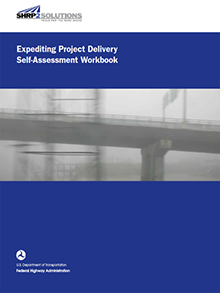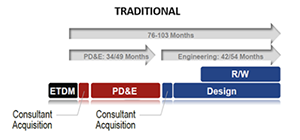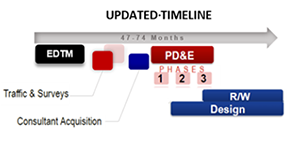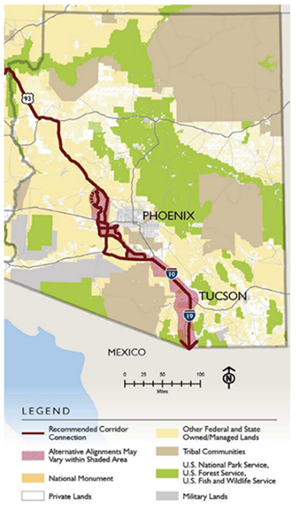Printer-friendly PDF →
Expediting Project Delivery (C19) Factsheet
This factsheet provides an overview of the Second Strategic Highway Research Program (SHRP2) product Expediting Project Delivery (C19), and provides resources available.

Photo sources: VTrans, Maricopa Association of Governments, USDOT Volpe Center

Expediting Project Delivery Self-Assessment. Workbook Source: FHWA
What is Expediting Project Delivery?
Expediting Project Delivery (C19) is a second Strategic Highway Research Program (SHRP2) Capacity solution to accelerate planning and environmental review of transportation projects. This product identifies 24 strategies to address or avoid 16 common constraints. The Transportation Research Board (TRB) developed this product and explained it in their report Expedited Planning and Environmental Review of Highway Projects.
What are the Benefits?
The strategies represent innovative approaches to improve transportation decision making that result in better projects and environmental outcomes. Applying these proven strategies saves time by allowing agencies to anticipate and reduce project delays.
Expediting Project Delivery Self-Assessment Workbook
This workbook allows agencies to lead their own assessment processes to identify opportunities to accelerate project delivery, and save time and resources without compromising environmental gains. The workbook can be found at: https://www.environment.fhwa.dot.gov/env_initiatives/shrp2/workbook.aspx.
For More Information
Contact
David Williams
Expediting Project Delivery Program Lead
FHWA Office of Project Development and Environmental Review
(202) 366-4074
David.Williams@dot.gov
Examples of Implementing Expediting Projecting Delivery Strategies
Expediting project delivery strategies have been successfully applied at a variety of scales and is gaining momentum among agencies. The following two examples highlight the improved outcomes and expedited project delivery realized. The case studies below can be found at the Expediting Delivery website at: https://www.environment.fhwa.dot.gov/env_initiatives/shrp2/library.aspx.
Timeline: 2 years (2013-2015)
Budget: $158,00
Florida Department of Transportation (FDOT) District IV
Reduce Categorical Exclusion Processing Time and Improving Project Delivery
|
Overview
FDOT District IV used eight strategies that fell under three themes to identify constraints that affected the timely delivery of their transportation projects. The themes were: 1) Improving resource agency involvement and collaboration; 2) Improving internal communications and coordination, and 3) Streamlining decision making.
FDOT held two Expediting Project Delivery Assessment workshops to identify potential expediting opportunities and develop implementation action plans. FDOT District IV successfully implemented its action plan with SHRP2 Implementation Assistance Program (IAP) technical assistance support, with additional process improvements planned.
|
Key Results
- Reduced Categorical Exclusion (CE) processing time
- Greater continuity and reduction of re-work, clearer scope of services, and efficient project programming
- Clearer scope of services
- Efficient project programming and funding
Next Steps
Institutionalize the results from this effort by continuing to modify the project schedule template and improve the tracking of pre-work in their project tracking system.
|

Traditional project delivery timeline. Source: FDOT

Updated project delivery timeline. Source: FDOT
|
Timeline: 2 years (2014-2016)
Budget: $240,00
Maricopa Association of Governments (MAG)
Intermountain West (IMW) Story Map and Model Risk Register for the I-11 Corridor
|
Overview
To address issues with capacity improvement in the region, MAG used two strategies from two C19 themes: 1) Improving resource agency involvement and collaboration, and 2) Streamlining decision making.
MAG, along with partner agencies and other stakeholders, undertook three activities to help expedite transportation project delivery: 1) Identified transportation- and geographic information system (GIS)-related data through outreach in the IMW region; 2) Developed the IMW Story Map, an interactive data tool for transportation planners; and 3) Developed a model risk register, which analyzes risk levels associated with delivering a transportation project, to assess risks in the Interstate 11 (I-11) corridor.
MAG created the IMW Story Map and a model risk register for the I-11 Corridor. This work expanded MAG’s existing cooperative efforts on an IMW transportation vision with various agencies throughout the IMW region.
|
Key Results
- Increased understanding of data resources in the region
- Increased communication
- Improved relationships among partner agencies
- Created a transferable data collection process
Next Steps
MAG will continue to foster the dialogue among partner agencies and stakeholders and pursue economic analysis in transportation planning.
|

I-11 and IWCS Recommended Corridor Alternatives.
Source: MAG C19 Report
|

